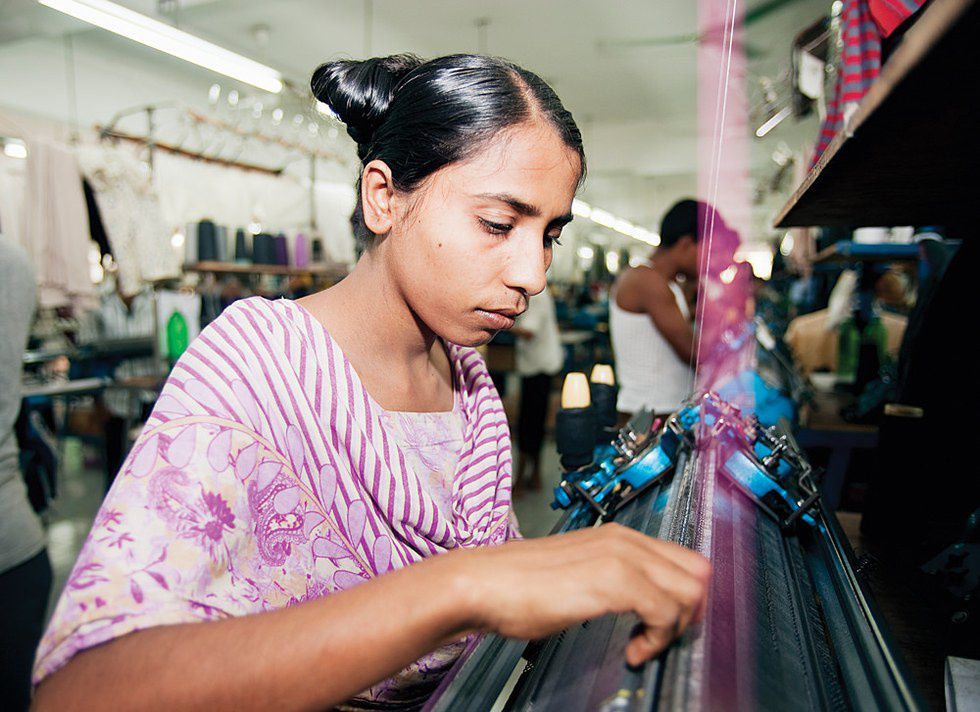I am a shopping enthusiast, and I love a good deal whenever and wherever I can find one. My mom has trained me to always look for coupons online and to scope out deals in store. I've typically been proud of my buys and tried not to fret over Sephora splurges, but even with my saving savvy eye I've been missing the bigger picture and the most important contributor to my wardrobe. "The True Cost", a Netflix documentary produced by Michael Ross and directed by Andrew Morgan, follows garment labor workers in some of the poorest countries and slums in the world all the way to the runway with a close look into the life of 23-year-old mother Shima and her daughter in Bangladesh.
It's hard to narrow down the facts and stress the importance of this documentary, but I'll do what I can to show you the heartbreak and urgent need I feel for you to take time and to watch "The True Cost" on your own time. Here are a few figures to consider:
1. The fashion industry is the world's second largest polluter; the oil industry is first.
2. The world consumes 80 billion pieces of clothing every year, which is up 400 percent in just two decades.
3. One in six people work in the fashion industry, and a majority of these workers are women living in a third world country earning less than $3 per day.
4. 250,000 Indian cotton farmers have committed suicide in the past 15 years partly because of rising debt due to the pressure to buy genetically modified cotton seeds.
5. Only 10 percent of the clothes donated to charity and thrift stores actually get sold. The remaining 90 percent ends up in a landfill or a third world country that buys the garments by the box-load, thus killing their own productive industry.
Maybe this all seems like irrelevant information - it doesn't impact you, not on the surface. But it does impact Shima and her daughter. 23-year-old Shima rises in the early morning to go work in a garment factory where she has seen her friends and fellow employees lose their job due to factory-sustained injuries and to death in terrible factory disasters. Though we're all entitled to human rights, there are not always organizations to protect them and thus working conditions can be clocked back decades -- think sweat shops, child laborers, 18-hour shifts with no break to go to the bathroom or grab a bite to eat (which in their case is rice, if they're lucky). Shima has to choose to bring her daughter with her to work, or to send her to a village for months at a time to be raised by someone else. Shima should be in school, exploring her youth and traveling, simply having a milkshake with friends. Her daughter should not have to worry that her mother may lose her job if she needs even an hour break or to a more terminal fate. Instead, Shima is one of the 40 million garment workers trapped in an unending cycle of feeding the greedy American runway. Her beautiful daughter is likely to find that the same fate awaits her should the same global brand-name stores continue to ignore their workers and their insufficient, illegal working conditions.
In addition to the human cost, there is an environmental one as well. Discarded clothing generates up to 82 pounds of textile waste every year, adding up to 11 trillion tons of textile waste from the United States alone. Cotton is now 90 percent genetically modified by using an exuberant amount of chemicals and pesticides, and this can pose a threat to the laborers and the buyers as the chemicals can seep into the skin if not properly handled and shipped overseas. Workers that stain leather products - your purses, boots, belts, wallets, etc. - are at increased risk for skin cancer by 25 to 50 percent because of harmful chemicals.
What can we do to stop the suffering of garment workers here at home, though? We can be informed about our favorite brands, stop buying from clothing industries that stand silent in the midst of garment factory disasters they're responsible for, and look for ways to spend and save in the right places. Here are five tips to get started:
1. Ask yourself, "Will I wear this at least 30 times? Can I wear this item with multiple outfits?" If your answer is no, consider passing it up because your later, unintentional discard of it costs more than just extra closet space.
2. Break the cycle of seasons. There are now 50 to100 mini-seasons within the traditional summer, autumn, winter, and spring seasons that cater to the fashion industry. A sweater wrap you wear in the winter may be paired with something in the spring - so stop throwing out your seasonal wear and don't depend too hard on the runway's must haves.
3. Spend your money in fashion with multiple intentions. Look for brands that compensate overseas workers with greater consideration and bonuses (hint: People Tree and Patagonia).
4. Detox your wardrobe. Check the tag for what your clothes are made of, and look up any harmful chemicals listed. Know your risks!
5. Join the Fashion Revolution that puts pressure on clothing industries to be more transparent about their employees and working conditions, and empowers consumers to be more intentional with their clothing shopping.
There are millions of young women sitting in an overcrowded, damp factory working for 15 plus hours to make less than $3 today. Less than $3 to feed themselves, let alone their families. Less than $3 for any health-related cost - which it can be assured that there are many health needs in their countries. Less than $3 for living conditions, let alone hygiene. As Americans, we cannot fathom living on less than likely $3 a day. As college students, we may joke around that we're penniless, but our comfort is endless supply around us and most of the time, we're wearing it.
I'm urging begging you to watch "The True Cost" to understand the heartbreak and urgency to end unfair garment labor, and to know #whomadetheirclothes.








 women in street dancing
Photo by
women in street dancing
Photo by  man and woman standing in front of louver door
Photo by
man and woman standing in front of louver door
Photo by  man in black t-shirt holding coca cola bottle
Photo by
man in black t-shirt holding coca cola bottle
Photo by  red and white coca cola signage
Photo by
red and white coca cola signage
Photo by  man holding luggage photo
Photo by
man holding luggage photo
Photo by  topless boy in blue denim jeans riding red bicycle during daytime
Photo by
topless boy in blue denim jeans riding red bicycle during daytime
Photo by  trust spelled with wooden letter blocks on a table
Photo by
trust spelled with wooden letter blocks on a table
Photo by  Everyone is Welcome signage
Photo by
Everyone is Welcome signage
Photo by  man with cap and background with red and pink wall l
Photo by
man with cap and background with red and pink wall l
Photo by  difficult roads lead to beautiful destinations desk decor
Photo by
difficult roads lead to beautiful destinations desk decor
Photo by  photography of woman pointing her finger near an man
Photo by
photography of woman pointing her finger near an man
Photo by  closeup photography of woman smiling
Photo by
closeup photography of woman smiling
Photo by  a man doing a trick on a skateboard
Photo by
a man doing a trick on a skateboard
Photo by  two men
two men  running man on bridge
Photo by
running man on bridge
Photo by  orange white and black bag
Photo by
orange white and black bag
Photo by  girl sitting on gray rocks
Photo by
girl sitting on gray rocks
Photo by  assorted-color painted wall with painting materials
Photo by
assorted-color painted wall with painting materials
Photo by  three women sitting on brown wooden bench
Photo by
three women sitting on brown wooden bench
Photo by 
 Photo by
Photo by  Photo by
Photo by  Photo by
Photo by  Photo by
Photo by 


 people sitting on chair in front of computer
people sitting on chair in front of computer



 all stars lol GIF by Lifetime
all stars lol GIF by Lifetime two women talking while looking at laptop computerPhoto by
two women talking while looking at laptop computerPhoto by  shallow focus photography of two boys doing wacky facesPhoto by
shallow focus photography of two boys doing wacky facesPhoto by  happy birthday balloons with happy birthday textPhoto by
happy birthday balloons with happy birthday textPhoto by  itty-bitty living space." | The Genie shows Aladdin how… | Flickr
itty-bitty living space." | The Genie shows Aladdin how… | Flickr shallow focus photography of dog and catPhoto by
shallow focus photography of dog and catPhoto by  yellow Volkswagen van on roadPhoto by
yellow Volkswagen van on roadPhoto by  orange i have a crush on you neon light signagePhoto by
orange i have a crush on you neon light signagePhoto by  5 Tattoos Artist That Will Make You Want A Tattoo
5 Tattoos Artist That Will Make You Want A Tattoo woman biting pencil while sitting on chair in front of computer during daytimePhoto by
woman biting pencil while sitting on chair in front of computer during daytimePhoto by  a scrabbled wooden block spelling the word prizePhoto by
a scrabbled wooden block spelling the word prizePhoto by 
 StableDiffusion
StableDiffusion
 StableDiffusion
StableDiffusion
 StableDiffusion
StableDiffusion









